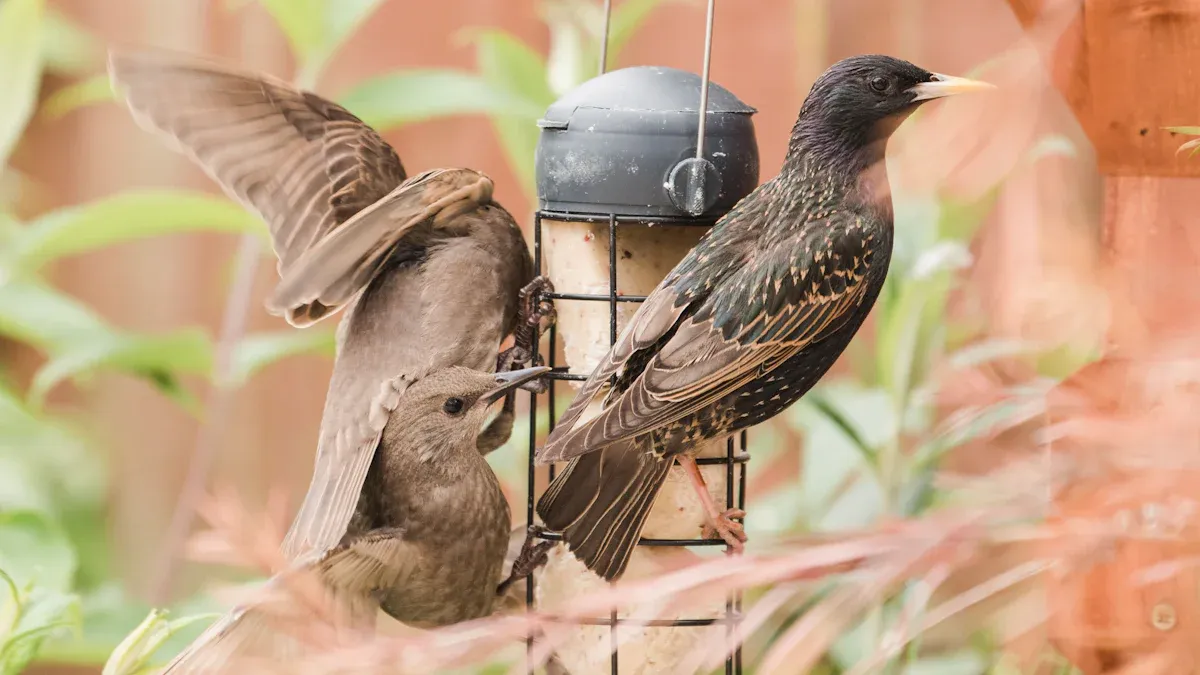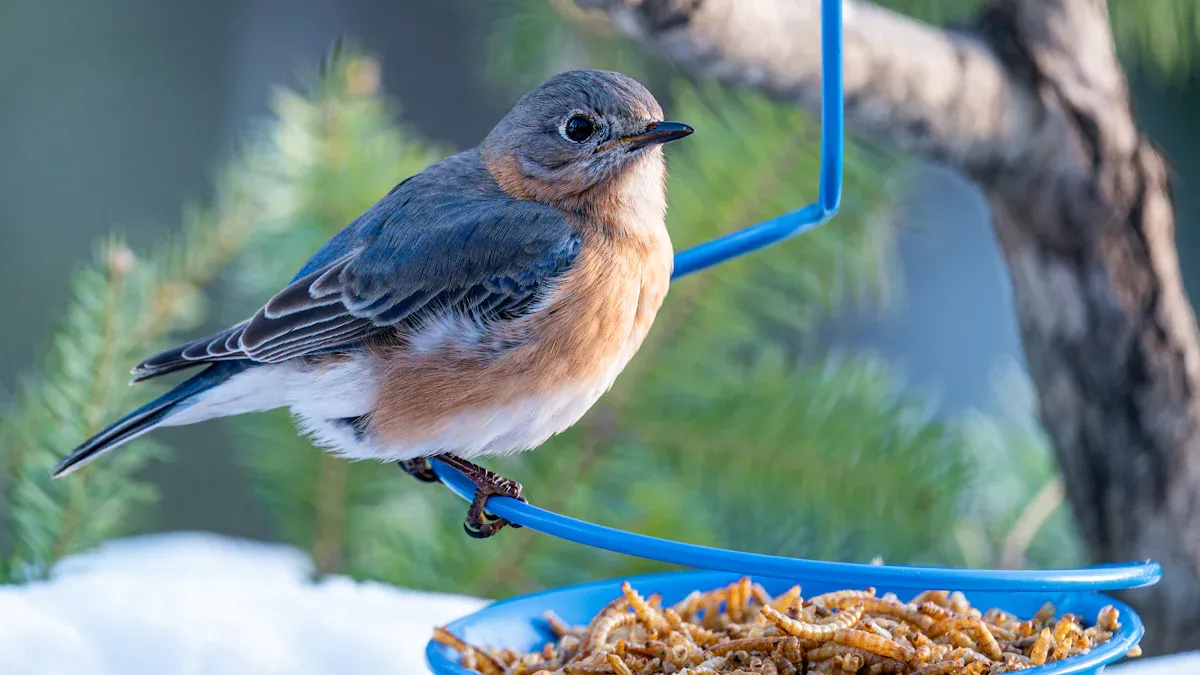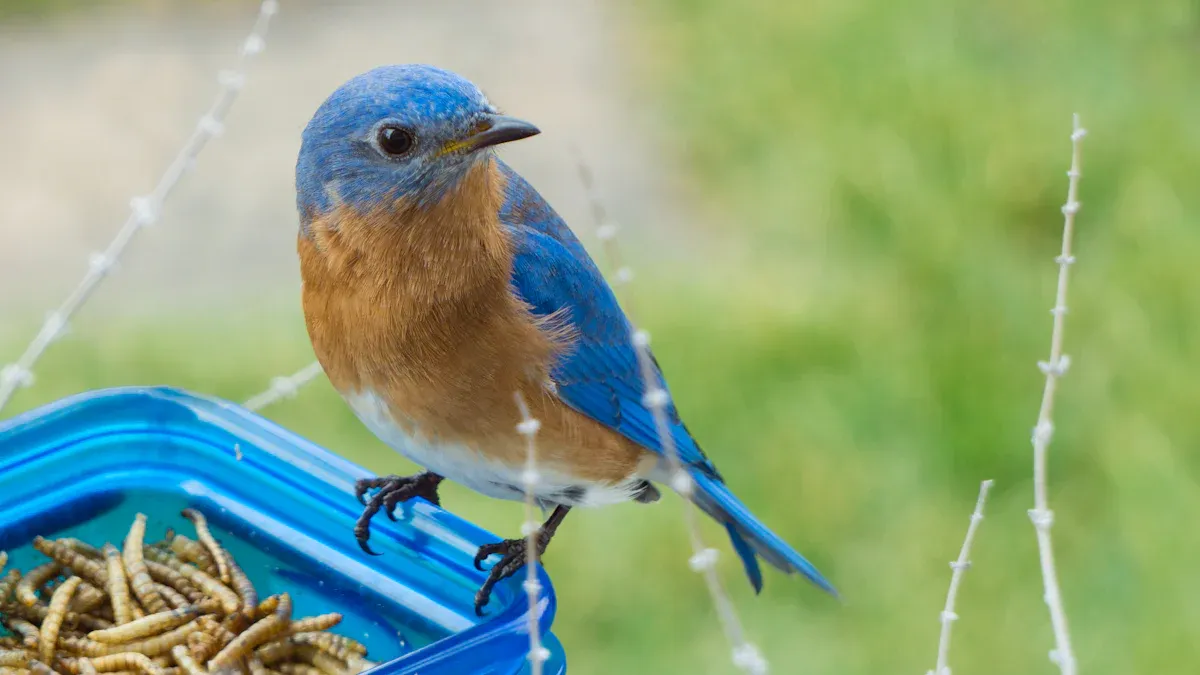
Birds love dried mealworm for bird feeding because they mimic their natural diet. Packed with protein, these treats are especially appealing during colder months and breeding seasons when birds need extra energy. You’ll also find them incredibly convenient—easy to store, handle, and serve. Plus, creating a bird-friendly yard brings endless joy as you watch nature thrive right outside your window.
Key Takeaways
- Dried mealworms are healthy snacks for birds. They give birds protein and fat, which are important in cold weather and breeding times.
- Dried mealworms are simple to use. They are easy to keep and serve, making bird feeding easy for everyone, even beginners.
- To bring in different birds, put dried mealworms in a good feeder. Keep it filled all year and change the amount based on bird visits and seasons.
Why Dried Mealworm For Bird Enthusiasts Is a Great Choice
Nutritional Benefits for Birds
Dried mealworms are a powerhouse of nutrition for birds. They’re packed with protein and fat, which are essential for energy and growth. During colder months or breeding seasons, birds need extra fuel to stay active and healthy. By offering dried mealworms, you’re giving them a reliable source of energy when they need it most. Birds that eat insects in the wild will especially appreciate this treat. It’s like giving them a taste of their natural diet right in your backyard.
Tip: Place dried mealworms in your feeder during early mornings or late afternoons when birds are most active. You’ll see them flocking in no time!
Convenience and Ease of Use
Dried mealworms are incredibly easy to handle. Unlike live mealworms, they don’t wiggle around or require special care. You can store them in a container, and they’ll stay fresh for a long time. Bird enthusiasts like Jennifer Kurdelski from Georgia love them because they’re economical and simple to use. Valerie Kirkham from Indiana also recommends them, saying they hold up well in both summer heat and winter cold. Whether you’re a beginner or an experienced bird feeder, dried mealworms make the process hassle-free.
“I put dried mealworms in a hanging platform feeder. Bluebirds, woodpeckers, wrens, and titmice enjoy them,” says Kay LeRoux from Florida. Why not try this method in your yard?
Year-Round Feeding Versatility
One of the best things about dried mealworms is their versatility. You can use them all year round, no matter the season. In winter, they provide much-needed energy when natural food sources are scarce. During spring and summer, they support birds during nesting and raising their young. They’re also perfect for fall, helping migratory birds prepare for their long journeys. No matter where you live, dried mealworms are a dependable option for attracting birds to your yard.
Birds love consistency. Keep your feeders stocked with dried mealworms, and you’ll enjoy their visits throughout the year.
Birds That Are Attracted to Dried Mealworms

Common Backyard Birds That Love Mealworms
You might be surprised by how many backyard birds enjoy dried mealworms. These protein-packed treats attract a variety of species, making your yard a lively birdwatching spot. Some of the most common visitors include:
- Bluebirds
- Chickadees
- Thrushes
- Titmice
- Wrens
- Nuthatches
- Kinglets
These birds are naturally drawn to insects, so dried mealworms fit perfectly into their diet. If you’re just starting out, try placing mealworms in a platform or tray feeder. You’ll likely see these feathered friends flocking to your yard in no time.
Tip: Keep a bird identification guide handy. It’s fun to match the birds you see with their names and learn more about their habits.
Seasonal Visitors and Migratory Birds
Dried mealworms aren’t just for your regular backyard visitors. They can also attract seasonal and migratory birds. During spring and fall, many birds pass through on their way to breeding or wintering grounds. Offering dried mealworms can give them the energy boost they need for their journey.
To make mealworms even more appealing during these times, try soaking them in lukewarm water. This softens the mealworms and makes them resemble live insects, which birds find irresistible. You might notice more activity at your feeders when natural food sources are scarce.
Birds often skip feeders when food is abundant in nature. Keep an eye on seasonal changes to adjust your feeding strategy.
Identifying Insect-Eating Birds in Your Area
Not all birds eat insects, so it’s helpful to know which species in your area might enjoy dried mealworms. Look for birds with thin, pointed beaks—these are often insect-eaters. You can also observe their behavior. Birds that hop along the ground or dart through trees searching for bugs are likely to love mealworms.
Local birdwatching groups or online forums can be great resources for identifying these species. You’ll also find that many bird identification apps include information about diet, helping you confirm which birds to expect at your feeder.
Note: Consistency is key. Once birds discover your feeder, they’ll return regularly if you keep it stocked with dried mealworms.
How to Serve Dried Mealworm For Bird Feeding

Choosing the Right Feeder for Mealworms
Picking the right feeder makes a big difference when serving dried mealworms to birds. You’ll want something that keeps the mealworms contained while still being easy for birds to access. A platform feeder or a rimmed dish works perfectly. These designs prevent the mealworms from spilling out or being blown away by the wind.
Place the feeder in a spot where birds feel safe. Look for areas near shrubs or trees, as these provide cover and make birds feel more secure. Avoid placing feeders too close to windows to reduce the risk of bird collisions.
Tip: If you’re just starting out, try a simple tray feeder. It’s easy to set up and attracts a variety of birds.
Best Placement of Feeders to Attract Birds
Where you place your feeder can determine how many birds visit your yard. Birds prefer feeders with a clear view of their surroundings. This helps them watch for predators while they eat. At the same time, they like having nearby vegetation for a quick escape if needed.
Keep feeders at least a few feet away from windows to prevent accidents. If you have a garden, try placing the feeder near flowering plants or bushes. This not only attracts birds but also creates a beautiful, natural setting for birdwatching.
Birds are creatures of habit. Once they find a safe and reliable food source, they’ll keep coming back.
Mixing Mealworms with Other Bird Foods
Dried mealworms are a fantastic treat, but you can make your feeder even more appealing by mixing them with other bird foods. Combine mealworms with seeds, suet, or fruit to attract a wider variety of birds. For example, bluebirds love mealworms, but adding berries might bring in robins or cardinals.
You can also experiment with layering foods in your feeder. Place mealworms on top of seeds to encourage birds to try them. Over time, they’ll associate your feeder with a dependable source of food and keep returning.
Pro Tip: Start with small amounts of mealworms and adjust based on how quickly birds eat them. This helps avoid waste and keeps the food fresh.
Storing Dried Mealworms Properly
Best Storage Containers for Mealworms
Choosing the right container is key to keeping your dried mealworms fresh and ready to use. Airtight containers work best because they keep moisture and pests out. You can use plastic storage bins, glass jars with tight lids, or resealable bags. If you buy mealworms in bulk, divide them into smaller portions and store them in separate containers. This way, you only open what you need, keeping the rest fresh.
Tip: Label your containers with the purchase date. This helps you keep track of freshness and ensures you use older mealworms first.
Ideal Storage Conditions to Maintain Freshness
Dried mealworms last longer when stored in the right conditions. Keep them in a cool, dry place away from direct sunlight. High temperatures or humidity can cause them to spoil faster. A pantry or a cabinet works well, as long as it’s not near a heat source like an oven or radiator. If you live in a humid area, consider adding a small packet of silica gel to the container to absorb moisture.
Birds love fresh mealworms. Proper storage ensures they stay tasty and nutritious for your feathered friends.
Preventing Spoilage and Pest Infestations
Spoiled mealworms can attract pests like ants or moths, so it’s important to take precautions. Always seal your containers tightly after each use. Check for signs of spoilage, like a bad smell or mold, before serving them to birds. If you notice pests in your storage area, clean it thoroughly and move the mealworms to a safer spot.
Pro Tip: Store mealworms in the freezer for long-term freshness. Freezing kills any potential pests and keeps the mealworms in perfect condition.
Serving Sizes and Feeding Frequency
Determining the Right Amount to Feed Birds
Finding the right amount of dried mealworms to feed birds can feel tricky at first, but it’s simpler than you think. Start small. A handful of mealworms (about 10-15 grams) is usually enough for a day, especially if you’re just beginning to attract birds. Watch how quickly they eat. If the mealworms disappear within an hour, you can add a bit more the next day.
Tip: Keep an eye on your feeder. If mealworms sit untouched for too long, reduce the amount to avoid waste.
Remember, birds don’t need to rely solely on your feeder. They’ll still forage for natural food, so your goal is to supplement their diet, not replace it.
Adjusting Feeding Based on Bird Activity and Season
Bird activity changes with the seasons, and so should your feeding routine. During spring and summer, birds are busy nesting and raising chicks. They’ll need extra energy, so you can increase the amount of mealworms slightly. In fall, migratory birds may stop by for a quick snack before their journey. Winter is another critical time when natural food is scarce. Offering more mealworms during these months can make a big difference.
On the other hand, during late summer when insects are abundant, you might notice fewer birds at your feeder. That’s normal! Just scale back the amount until activity picks up again.
Avoiding Overfeeding and Food Waste
Overfeeding can lead to wasted food and even attract unwanted pests. To avoid this, only put out as much as birds can eat in a day. If you notice leftover mealworms, reduce the portion size. It’s better to refill your feeder more often than to let food go to waste.
Pro Tip: Clean your feeder regularly to prevent mold or bacteria from building up. A clean feeder keeps your feathered visitors healthy and happy.
Cost-Saving Tips for Buying Dried Mealworms
Benefits of Buying in Bulk
Buying dried mealworms in bulk can save you a lot of money in the long run. Larger packages often come with a lower price per ounce compared to smaller ones. If you’re feeding birds regularly, this is a smart way to stretch your budget. Bulk buying also means fewer trips to the store or online orders, saving you time and effort.
Tip: Check the expiration date before purchasing in bulk. Proper storage ensures your mealworms stay fresh for months.
Comparing Prices Online and Locally
Shopping around can help you find the best deals. Online retailers often offer discounts, especially for larger quantities. You can also compare prices across different websites in just a few clicks. Local stores, on the other hand, might have seasonal sales or loyalty programs that save you money.
Make a habit of checking both options. Sometimes, local stores offer better deals when you factor in shipping costs. Don’t forget to read reviews to ensure you’re getting quality mealworms at a fair price.
Pro Tip: Sign up for email alerts from online stores. You’ll get notified about discounts and special offers.
DIY Alternatives to Reduce Costs
If you’re feeling creative, you can try raising your own mealworms at home. It’s easier than you think and can significantly cut costs. All you need is a container, some wheat bran, and a few starter mealworms. Over time, they’ll multiply, providing a steady supply for your feathered friends.
Raising mealworms is a fun project that’s both cost-effective and eco-friendly. Plus, birds love the fresh ones even more!
Using dried mealworms is a simple way to attract and nourish birds in your yard. They’re packed with nutrients, easy to handle, and loved by many bird species. Why not give them a try?
Watching birds flock to your feeder is a rewarding experience. You’ll enjoy the beauty of nature right from your window! 🐦
FAQ
What types of birds will eat dried mealworms?
Many birds love mealworms! Bluebirds, wrens, chickadees, and woodpeckers are common visitors. You might even attract migratory birds during spring and fall. 🐦
Can I soak dried mealworms before feeding them?
Yes, soaking mealworms makes them softer and more appealing. Birds love the texture because it mimics live insects. Just use lukewarm water for a few minutes.
How often should I refill my feeder with dried mealworms?
Refill daily or as needed. Watch how quickly birds eat them. Adjust portions to avoid waste and keep the food fresh for your feathered friends.


